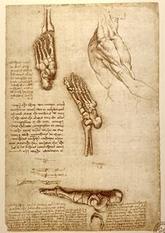@DBT9
European and Western studies
Even if it is thought that reflexology was mainly an Eastern tradition. it has to be known that in Europe too it has a long tradition. In XVI Century the famous Italian artist Benvenuto Cellini was treated by pressures on his hands and feet to help him for muscle pains. In the same Century Leonardo da Vinci studied in detail the feet anatomy and physiology. In XIII and XIV Centuries Marco Polo and some missionaires brought the massage and reflex knowledge known in the Far East, but the European tradition did not change much. In 1834 the Swedish scholar P.H. Ling noticed the relation between the pain of some body organs and feet points. Henry Head used reflexed pints for anaesthetic purposes and later on W. Fitzgerald tested more extensively these relations (1913). It is known in Europe and North America also as "zone therapy". Almost in the same years of the XX Century, in Italy two important scholars were the physicians N. Gentile and G. Calligaris, they, independently from foreign activities, realised important researches and published some books about reflex-therapies and applications. Since the second half of the XX Century it had a wider diffusion (also by E. Ingham and H. Marquardt) in people and a growing interest among scholars of different traditions (biologists, physicians, psychologists, etc.). Today for several reasons (confusion of information, improvised experts, prejudices, etc.) reflexology still receives conflicting assessments and still is not much considered from the "official" medicin (outside research studies).
https://www.reflexologystudio.org/reflexology-from-ancient-traditions-to-science.html
- Forums
- Philosophy & Religion
- What Is Consciousness?
What Is Consciousness?, page-122
-
-
- There are more pages in this discussion • 127 more messages in this thread...
You’re viewing a single post only. To view the entire thread just sign in or Join Now (FREE)
Featured News
Featured News
The Watchlist
LPM
LITHIUM PLUS MINERALS LTD.
Simon Kidston, Non--Executive Director
Simon Kidston
Non--Executive Director
SPONSORED BY The Market Online










